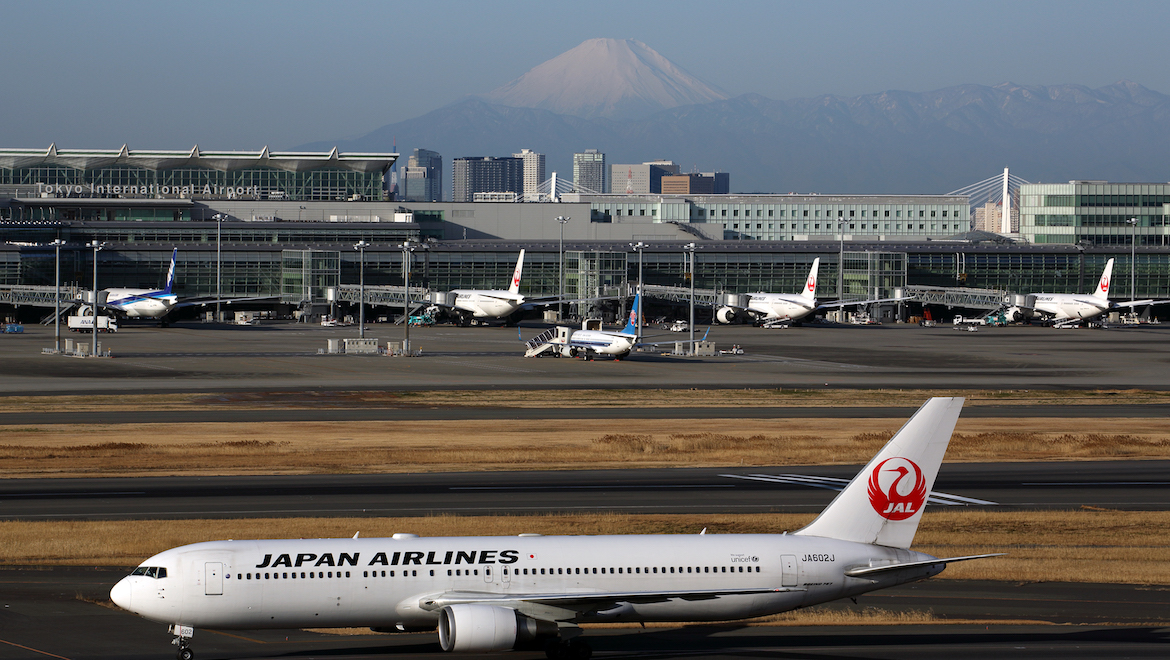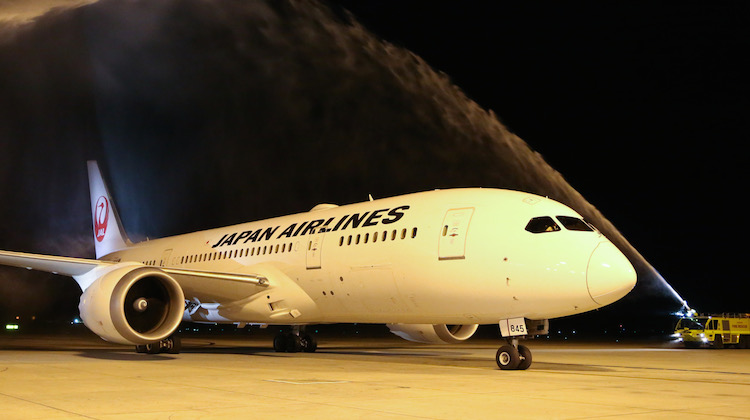
Qantas has unveiled plans to add a second daily service between Sydney and Tokyo Haneda and switch its Melbourne-Tokyo Narita nonstop flight to the close-in Tokyo airport.
The Australian carrier has applied for the two new slots at Tokyo Haneda Airport that were recently allocated by the Japanese Ministry of Land, Infrastructure, Transport and Tourism (MLIT).
The application to Australia’s International Air Services Commission (IASC), which manages the country’s traffic rights, said switching its current Melbourne-Tokyo Narita service to Tokyo Haneda would “immediately open connections to as many as 18 new points in Japan and Korea using partner airlines”.
“Qantas’ plans for daytime Haneda services will provide direct access between Melbourne and Haneda for the first time – a city pair that is not currently served non-stop by any other carrier,” said the submission, which was published on the IASC website on Tuesday.
“A new Qantas Melbourne-Haneda service provides a more geographically diverse and competitive market structure between Australia and Haneda, reaching a broad catchment area across Australia with greater connectivity for regional Victoria, Tasmania and South Australia.”
Meanwhile, Qantas said an additional daily Sydney-Tokyo Haneda rotation at an alternative timing to its current daily flight – which is an overnight service in both directions – would provide more choice and greater convenience for these travellers heading directly to downtown Tokyo.
It would also provide “new or improved connectivity to 16 destinations across Australia and the South Pacific”.

The Japanese MLIT allocated a total of four new slot pairs for Australia-Tokyo Haneda routes, comprising two new slot pairs for Japanese carriers – one for All Nippon Airways (ANA) and one for Japan Airlines – and two new slot pairs for Australian carriers.
Also, the slots would be for daytime services – notionally between 0600 and 2255 – as air traffic managers opened up more airspace in the Tokyo area to support the additional flights.
The IASC said on September 3 it was aiming to allocate them by October 31 2019 in order to enable Australian carriers to take up the available slots from March 29 2020, the start of the 2020 northern summer scheduling period.
It described the deadline as a “tight timeframe”.
Qantas said it was well-placed to immediately utilise the new capacity into Tokyo Haneda with “no risk to Australia’s access to these valuable and scarce slots”, given its existing service to the close-in airport.
“Any potential delay to the commencement of services by a carrier applying for capacity or disruption to operations will place these highly valuable slots, future access and the strong, longstanding relationship that Australia maintains with Japan at risk,” the Qantas submission said.
“This could set an international precedent which negatively impacts Australia’s prospects or leverage in negotiations on future access with Japan or more broadly with other strategic partners.
“For other potential applicants without an existing operational footprint, there is a risk that regulatory requirements to launch services to Japan may not be completed in advance of NS20. These requirements include, but are not limited to, slots, security, safety, operations specifications, regulatory, schedule and business registration.”
Further, Qantas said its plans to add flights to Tokyo Haneda did not deny competition from other Australian carriers, noting there was unrestricted capacity for operating into Tokyo Narita and other points Japan under the current air services agreement between the two countries.
Currently, both ANA and Qantas offer nonstop flights between Sydney and Tokyo Haneda.
ANA started Boeing 787 services on the route in December 2015, when it returned to Australia after more than a decade away from the market.
Meanwhile, Qantas switched its daily Boeing 747-400/400ER Sydney-Tokyo services from Narita to the close-in Haneda airport in July 2015.
A second daily Sydney-Tokyo Haneda service would enable Qantas to grow seat capacity at the close-in Tokyo airport as the 747 fleet was retired by the end of 2020.
Qantas’s 747-400/400ERs have 364-seat in a three-class configuration, with 58 in business, 36 in premium economy and 270 in economy.
Meanwhile, the airline’s Airbus A330-200s and A330-300s have either 251, 271 or 297 seats in a two-class configuration – business and economy.
Finally, its 787-9s have 236 seats in a three-cabin layout of business, premium economy and economy.
Other nonstop flights between Australia and Japan included Sydney-Osaka Kansai (Qantas), Sydney-Tokyo Narita (Japan Airlines), Melbourne-Tokyo Narita (Japan Airlines and Qantas), Brisbane-Tokyo Narita (Qantas) and the recently commenced Perth-Tokyo Narita service from ANA.
Also, Qantas’s low-cost carrier (LCC) unit Jetstar has three routes – Gold Coast-Tokyo Narita, Cairns-Osaka Kansai and Cairns-Tokyo Narita.
And there is new capacity coming later in 2019, with Qantas scheduled to operate a seasonal Sydney-Sapporo nonstop flight with Airbus A330 equipment between December 2019 and March 2020.
While Virgin Australia does not fly to Japan with its own aircraft, it sells codeshares services between Australia and Japan on flights operated by its alliance partner Singapore Airlines (SIA).


Tokyo Haneda Airport, which is located much closer to Tokyo city than Tokyo Narita, had previously been predominantly used by Japanese carriers as a domestic airport.
However, there have been efforts to expand the number of international services at Haneda amid a Japanese government push to attract more tourists to the country.
The Rugby World Cup, which starts later in September, is being played across Japan. Meanwhile, in 2020, Tokyo will host the summer Olympics and Paralympics.
Japan is targeting 40 million annual visitors to the country by 2020.
The allocation was among a package of 50 slot pairs for international services at Tokyo Haneda that was distributed on Monday, with 25 for Japanese airlines and 25 for international carriers.
















Bart
says:Hot off the press, Virgin have applied for approval to operate into Haneda… Go get em Virgin!!!!
anon
says:Virgin Australia just applied for a slot at Haneda.
Lechuga
says:Hopefully Melbourne is first.
Greg Smith
says:You forgot the JQ services from OOL and CNS to NRT and KIX
australianaviation.com.au
says:Hi Greg,
Thanks for the reminder. The story has been updated. Apologies for the omission and thank you for reading.
Phil
says:I’m concerned that having Virgin apply for the slot means that MEL-HND flights may not happen since Virgin certainly will have SYD-HND and Qantas would prioritise SYD-HND over MEL. Unless JAL or ANA do MEL-HND but who knows?
Red Cee
says:According to the article on Australian Aviation re Virgin applying to fly to Haneda, they are submitting an application to do so. They have until the 24th of September. Considering Virgin don’t currently fly to Japan, it will be interesting to see the outcome.
Scott
says:Those comments from Qantas re Virgin are an ALLTIME low and without fact (and that’s putting it politely) I hope the IASC sees through them for what they are, maybe allocate in reverse. Never heard of an application not to focus solely on their own positives but to slander an alternative and request ALL slots for themselve.
The Japanese airline slots allocations are 1 JAL and 1 ANA why should this end be any different.
Jim
says:Eh Scott, JAL and ANA are airlines with real international networks, plus being home carriers of course they would get the most priced slots evenly when there are only 2.
Virgin Australia, on the other hand, has a total of 7 international destinations outside of New Zealand. They have no local partner in Japan, no airport operations and sales set up either. They’d also stretch their fleet pretty thin to add Japan on their destination list, why do you think they never announced a Narita flight when it’s always been available for them to do so?
Scott
says:Jim read my comment, the Japanese allocation makes total sense. One each for ANA and JAL, I’m saying this should be replicated on the Australian end , 1 each for VA and QF, I’m NOT advocating for VA to be allocated a Japanese airline allocated slot. QF taking all is a distortion.
Jim
says:Scott, why should that be? Because there are 2 slots and 2 airlines? If Virgin could prove that they could actually run the route for such a priced slot (eg. daily return from day one, have the infrastructure set up so they can keep the flight going), which many doubt could be the case, then sure, they should be allocated a slot. However, just because there are 2 airlines doesn’t mean 2 slots must be allocated evenly. I ask the question again, Narita is always available, why has Virgin not even bothered to set up to fly to Narita?
Red Cee
says:Scott, we follow what you are saying. We understand that you want the two Australian Airlines to be offered a slot each.
Red Cee
says:Question remains, if Virgin are given a slot, and then find they can’t continue, due to operational costs, what happens to that slot?
Scott
says:What are you on about Red Cee, the focus is on allocation of the slots. Pulling out? if I recall Qantas entered and pulled out of Dubai, Rome, Frankfurt, San Fransisco, the list goes on and on. No airline is immune from schedule/ destination changes Qantas has had plenty. In fact Australian Airlines flew to 6 destinations in JAPAN and pulled out of all of them.
Re your comments on aircraft availability, let’s leave that to the airlines planning department, BOTH airlines would have to find a aircraft for the new route. Re setup Virgin have done it before with Hong Kong on tight timelines and would do it again for Haneda.
Takayuki Yamada
says:Wish that Virgin Australia comes to japan. It’s great that choice can be increased. But since Virgin Atlantic withdrew service from Japanese market, recognition of Virgin airways is getting less. I’m member of QF club long time as well as ANA SFC. Success of marketing might can be how cooperate with Japanese carriers and might joining some kind of air alliance. Hope some new strategy go forward and wishing to see Virgin Australia aircraft to be seen in Japan! Possibly some time future in Nagoya!?